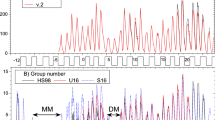Abstract
Because of the renewed attention now paid to the solar diameter, its variations from equator to pole, or its secular or long-period changes, the question: what is a solar diameter? is not meaningless. Two kinds of definitions may be given: either astrophysical, each one relating to a specific physical parameter, or observational, relating to a given quantity to be measured. Only the second kind is directly accessible, and astrophysical definitions should be linked to these quantities, once they are determined with the highest possible accuracy. In practice, all the programs under way refer to the point of the limb where the brightness gradient is maximum, or to a higher order approximation of the shape of the profile. Two of them are compared: the Pic-du-Midi experiment, using fast scans of the limb to define the inflection point after a correction for the blurring effect of the atmosphere, and the SCLERA experiment, using the algorithm called FFTD to eliminate this correction. The advantage of a fast scan is emphasized, and the remark is formulated that, once the signal is digitized and stored, FFTD or any processing of it can be performed. In collecting day-long one-limb scans to calibrate the blurring correction, the authors have found fluctuations of the maximum brightness gradient which provide a new entry to the field of solar oscillations.
Similar content being viewed by others
References
Brandt, P. N.: 1970, Solar Phys. 13, 243.
Dicke, R. H. and Goldenberg, H. M.: 1967, Phys. Rev. Letters 18, 313.
Dunn, R. B. (ed.): 1981, Solar Instrumentation - What's Next, Sacramento Peak Observatory, September 1980.
Eddy, J. A. and Boornazian, A. A.: 1979, Phys. Today 32, 17.
Fried, D. L.: 1966, J. Opt. Soc. Am. 56, 1427.
Hill, H. A.: 1981, in R. B. Dunn (ed.), Solar Instrumentation - What's Next, Sacramento Peak Observatory, September 1980, p. 300.
Hill, H. A., Stebbins, R. T., and Oleson, J. R.: 1975, Astrophys. J. 200, 484.
Hill, H. A., Rosenwald, R. D., and Caudell, T. P.: 1978, Astrophys. J. 225, 304.
Knapp, J., Hill, H. A., and Caudell, T. P.: 1980, Lecture Notes in Physics, No. 125, Springer-Verlag, Berlin, p. 394.
Parkinson, J. H., Morrison, L. V., and Stephenson, F. R.: 1980, Nature 288, 548.
Rösch, J.: 1962, Symposium on Solar Seeing, Roma, Consiglio Nazionale delle Ricerche, p. 38.
Rösch, J. and Yerle, R,: 1981, in R. B. Dunn (ed.), Solar Instrumentation - What's Next, Sacramento Peak Observatory, September 1980, p. 366.
Stebbins, R. T.: 1980, Lecture Notes on Physics, No. 125, Springer-Verlag, Berlin, p. 191.
Yerle, R.: 1981, Astron. Astrophys. 100, L23.
Author information
Authors and Affiliations
Additional information
Proceedings of the 66th IAU Colloquium: Problems in Solar and Stellar Oscillations, held at the Crimean Astrophysical Observatory, U.S.S.R., 1–5 September, 1981.
Rights and permissions
About this article
Cite this article
Rösch, J., Yerle, R. Solar diameter(s). Sol Phys 82, 139–150 (1983). https://doi.org/10.1007/BF00145554
Issue Date:
DOI: https://doi.org/10.1007/BF00145554




